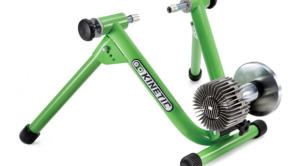This summer, Wahoo released the little brother to the popular KICKR smart trainer, the KICKR SNAP, for $849 (see below for the much lower street price). I have been using the original KICKR since it first came out and I initially thought the SNAP was a watered down version of the KICKR. After a couple months of heavy use, I now believe the KICKR SNAP is much more than that.
The KICKR SNAP setup is just as easy as the KICKR. It uses the same Wahoo apps for firmware updates and the same spin-down procedure to improve the power meter accuracy. It took me more time to remove the KICRK SNAP from the box than to get it running. Included with the SNAP is a power cord and a QR skewer.
At first glance it appears very similar to the original KICKR, just with a wheel-on design versus direct drive. The flywheel is slightly smaller (and 2.5 lbs lighter), but the general construction, dimensions, and sturdiness of the trainer remain. The electronics within the SNAP are nearly identical to the KICKR: Ant+, Bluetooth, FE-C, resistance control, ability to update firmware via Wahoo App, and basic power measurements. The KICKR SNAP specifications do state decreased power accuracy (5% vs. 3%), lower max wattage (1100 watts vs. 1550 watts) and not as much incline as with the KICKR. However, I never noticed any of these down-specs during my day-to-day use.

There were subtle differences in the design that were very nice. The SNAP folds flat to the ground, making it great for storage and transportation, quite a contrast to the bulky KICKR.

Also, the power cord plugs into the rear of the flywheel. I found this to be a more logical location versus the original KICKR, which houses the power connector in the front of the flywheel.

As much as I enjoyed these design improvements, I would have liked the KICKR SNAP to retain the ability to adjust the leg height, as with the KICKR, and a flatter design where it meets the floor. Although these are subtle differences they were enough to leave me with the impression that the KICKR is slightly more solid than the KICKR SNAP under heavy load.
The locking mechanism for my rear wheel was by far the nicest I have used for wheel-on trainers. It has a large handle along with the standard spin lock on the QR side. The SNAP required much less force to securely lock my rear wheel than other wheel-on trainers. Also, the knob to adjust the resistance was easy to turn and ergonomic in its design.

One of the major advantages to choosing KICKR SNAP over some other wheel-on smart trainers is its compatibility. Wahoo makes its devices open to nearly all software platforms (e.g., TrainerRoad, Virtual Training, Wahoo), an advantage.
I was also surprised how much I enjoyed the wheel-on design coming from the world of direct mount. During the outdoor riding season I used a road tire for my indoor training and I was able to quickly shift from indoor to outdoor riding without fiddling with my rear wheel. Further, the sound difference between the KICKR and KICKR SNAP was barely noticeable.
A small word of caution for those with Di2: depending on where your e-tube cable exits to the rear derailleur, it could be dangerously close to the locking mechanism when you lock your rear wheel to the KICKR SNAP.

The KICKR SNAP is another great trainer from Wahoo. There are certainly competitors, like Tacx and CycleOps, who produce quality smart trainers in a wheel-on design, sometimes for less money. But every brand must reckon with all the features of the KICKR SNAP. It is most definitely not a watered down KICKR, but a great trainer that stands up on its own.
Street price on the KICKR SNAP as of this writing is $699.


